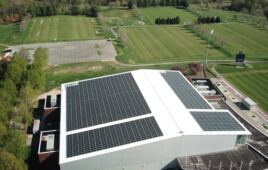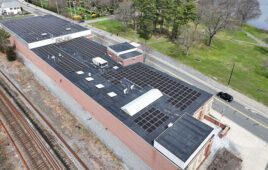By Michael Barry, design and communications for Solar One
In 2012, the East Coast of the U.S. was struck by an unprecedented weather event: Hurricane Sandy.
When the storm hit the New York area, it left a trail of destruction in its wake. Power went out for hundreds of thousands of area residents.
In the immediate aftermath of the storm, one point became abundantly clear: New York City and the region had a power grid that was incapable of resisting such a storm. The result was that dozens of densely populated and already marginalized communities were without power for weeks.
At the time, Solar One, a nonprofit primarily focused on urban sustainability and green energy education, had the only fully solar-powered building in New York City. Sandy’s 13-foot storm surge left the entire area, from the East River up to First Avenue, under several feet of water, and the Solar One building and the entire park were inundated. But since the designers of the little building had the foresight to install the battery storage and inverters in the loft space, after the surge, Solar One staff simply drained water from the building and flipped the power switch back on.
Luck favors the prepared, and since they could make phone calls and use computers, the staff of Solar One, with the help of a small solar company from Pennsylvania, Consolidated Solar, which offered portable solar generators, could coordinate with leaders from storm-ravaged communities and provide mobile 10-kW generators to communities that desperately needed electricity. When neighborhoods regained power, the generators were sent to other locations still in need.
During the weeks after the storm, dozens of communities could charge cell phones, use computers, communicate with the rest of the world and get at least some electricity from these generators, and the Solar One building, lights on throughout, became an essential community hub.
It was then that the light bulb (solar powered and LED of course!) flipped on in the mind of Solar One’s executive director, Chris Collins.
“It was clear that there was both a previously unimaginable problem and a potential solution,” Collins said. “The 100-year storm had arrived, and we likely would not need to wait another hundred years before the next one. But if we had decentralized and distributed solar power and battery sources, communities could be more resilient in the face of disasters like Superstorm Sandy. It was in the immediate wake of the storm that we conceived of our Here Comes Solar program, and by 2014 the program was up and running.”
Here Comes Solar
Solar One’s Here Comes Solar (HCS) program works to make solar power and storage accessible and affordable for all New Yorkers, especially in underserved and high-needs market segments. New York City has very strict regulations regarding the use of batteries for solar power storage, so the HCS team is working hard to make a case for safety and loosening of restrictions. To that end, a new project is underway that will install solar-plus-storage at four crucial community organizations in the area including two ambulance corps, a school and a family services center. The hope is that once safe operation is proven, the city can be enticed to amend the current regulations.
Solar One observed that despite NYC’s high electricity rates and favorable state policies, urban solar adoption was being dramatically outpaced by the suburbs, where there are less regulatory and administrative barriers, simpler building ownership structures and a more uniform and contiguous solar market. For most regional and national solar companies, New York City, with its space-constrained roofs, notorious permitting process and complex multifamily building ownership structures, is anything but low-hanging fruit.
HCS works to overcome these barriers by providing comprehensive technical assistance to building owners, educating them regarding the costs and benefits of solar, helping them secure financing and finally competitively soliciting bids from qualified solar installation companies.
HCS program participants regularly secure highly competitive pricing because Solar One eliminates customer acquisition costs for participating solar installers and strategically develops projects in close geographic proximity to reduce installer mobilization costs. Since 2014, the program has helped more than 200 NYC buildings adopt solar. Initially the program focused on organizing solar purchasing groups for the 1-4 family rowhome market, and in 2016, HCS shifted focus toward other underserved market sectors including multifamily and affordable housing, resilient solar and community solar.
Multifamily solar opportunities
In 2017, HCS facilitated NYC’s first multifamily affordable housing PPAs on supportive housing facilities in the Lower East Side and East New York, Brooklyn. HCS is working with affordable housing providers citywide, as well as environmental justice groups in Harlem, the Bronx and Brooklyn to organize group purchasing campaigns and to develop community shared solar projects for low-income communities. The HCS team also works on larger projects and recently provided technical assistance to help make a case for solar on Stuyvesant Town’s rooftops.
StuyTown, as it’s called by New Yorkers, is a huge apartment complex on midtown Manhattan’s east side with a total of 110 residential buildings, 11,250 apartments and more than 25,000 residents. Upon completion, the system is expected to generate about 3.8 MW of power, making it the largest multifamily rooftop array in the United States.
To date, the HCS program is responsible for 6.3 MW of solar projects, including more than 2 MW on affordable housing. As the program adds community shared solar to its portfolio, the team expects to dramatically increase its overall capacity and impact in 2018-2019.
 “Looking at solar for the first time can be daunting,” said program director Noah Ginsburg. “There’s plenty of information, but not much translation into terms that are meaningful for New York residents. The Here Comes Solar program occupies a singular niche in the NYC solar market. As a nonprofit, we can provide affordable housing communities, building managers and co-op boards with unbiased information and assistance so that they can make well-informed decisions to go solar. We are here to support them with every step of the process, making the benefits of solar available to all New Yorkers.”
“Looking at solar for the first time can be daunting,” said program director Noah Ginsburg. “There’s plenty of information, but not much translation into terms that are meaningful for New York residents. The Here Comes Solar program occupies a singular niche in the NYC solar market. As a nonprofit, we can provide affordable housing communities, building managers and co-op boards with unbiased information and assistance so that they can make well-informed decisions to go solar. We are here to support them with every step of the process, making the benefits of solar available to all New Yorkers.”
As it enters its fourth year, the program is embraced by those who benefit most—residents and tenants of working neighborhoods—and that is where the focus of the team remains. Low-income neighborhoods have the most to gain financially from solar power and low-lying coastal neighborhoods can least afford to be without power when disaster strikes.
Here Comes Solar’s goal is to empower all New Yorkers to participate in and benefit from solar. Together with its partners, program participants and supporters, Solar One is helping New Yorkers save money while mitigating climate change and improving community resilience.








Tell Us What You Think!